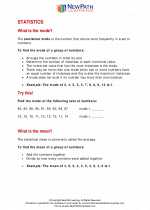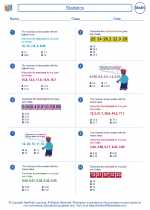Statistics
Statistics is a branch of mathematics that involves collecting, organizing, analyzing, interpreting, and presenting data. It is used to make informed decisions and predictions based on numerical information. In this study guide, we will cover some of the key concepts in statistics that are important for fifth grade students to understand.
Key Concepts in Statistics
- Data Types: In statistics, data can be categorized into two main types: numerical and categorical. Numerical data consists of numbers and can be further divided into discrete (whole numbers) and continuous (decimal numbers) data. Categorical data consists of categories or labels.
- Data Representation: Data can be represented using different graphical methods such as bar graphs, line graphs, pictographs, and pie charts. Each type of graph is used to represent different types of data and can help in visualizing and comparing information.
- Measures of Central Tendency: Measures such as mean, median, and mode are used to describe the center of a set of data. The mean is the average of a set of numbers, the median is the middle value when the data is arranged in order, and the mode is the value that appears most frequently in a set of data.
- Probability: Probability is the likelihood of an event occurring. It is expressed as a number between 0 and 1, where 0 represents an impossible event and 1 represents a certain event. Probability can be calculated using the formula:
Probability = (Number of favorable outcomes) / (Total number of possible outcomes)
Study Tips for Statistics
Here are some tips to help you understand and succeed in learning statistics:
- Practice collecting and organizing data from everyday situations. This could involve keeping track of favorite colors, types of pets, or daily temperatures.
- Use real-life examples to understand statistical concepts. For example, use sports statistics to calculate averages or use survey data to create graphs and interpret results.
- Work on problems step by step. Break down complex problems into smaller, manageable steps to better understand the concepts and calculations involved.
- Review and understand the different types of graphs and when each is most appropriate for representing specific data sets.
- Practice calculating measures of central tendency (mean, median, mode) for different data sets to enhance your understanding of these concepts.
- Understand the basics of probability and use examples to calculate the likelihood of different events occurring.
By mastering the fundamental concepts and practicing problems, you will be well-prepared to tackle statistical problems and apply your knowledge to real-world situations.
Good luck with your studies!
[Statistics] Related Worksheets and Study Guides:
.◂Math Worksheets and Study Guides Fifth Grade. Statistics
Study Guide Statistics
Statistics  Worksheet/Answer key
Worksheet/Answer key Statistics
Statistics  Worksheet/Answer key
Worksheet/Answer key Statistics
Statistics  Worksheet/Answer key
Worksheet/Answer key Statistics
Statistics 

 Worksheet/Answer key
Worksheet/Answer key
 Worksheet/Answer key
Worksheet/Answer key
 Worksheet/Answer key
Worksheet/Answer key

The resources above cover the following skills:
Data Analysis and Probability (NCTM)
Select and use appropriate statistical methods to analyze data.
Use measures of center, focusing on the median, and understand what each does and does not indicate about the data set.